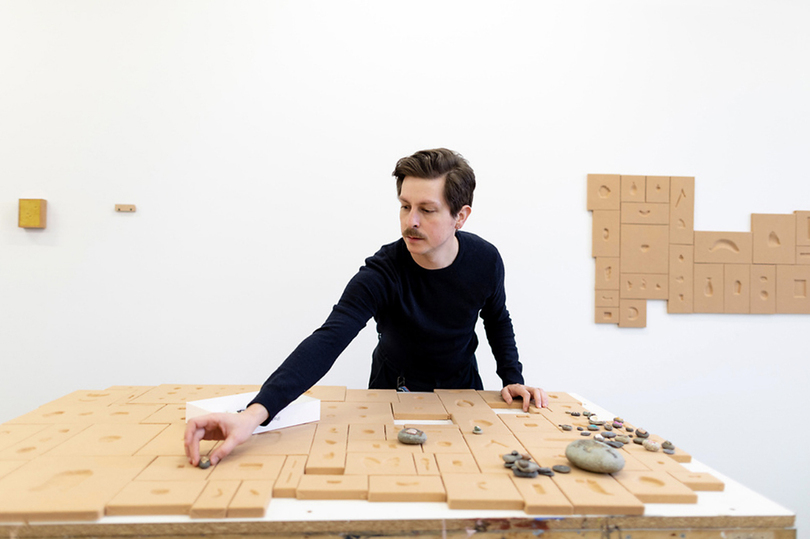Adam Milner incorporates bodily fluids in new art exhibition at The Everson

Courtesy of Adam Milner
Adam Milner, will be speaking about his artistic process at the Everson Museum of Art. He uses different types of materials in his artwork including blood.
Slowing to a stop, Adam Milner’s father put the car in park to let Milner and his sister out of the car. Standing before the Denver Art Museum as kids, Milner and his sister ventured into the museum together to explore every exhibition.
Milner admired the different mediums and techniques artists used and the range of emotions he felt when viewing works. He found himself observing some pieces and imagining himself creating a similar project.
Even as a child, Milner said he always knew art was a part of his identity.
“I remember being really struck by the materiality of things,” Milner said. “I was inspired by seeing things from different times and places with such different processes and materials and ideas behind them.”
Now, Milner’s upcoming exhibition, “Late Night Space Force,” at the Everson Museum of Art will run from Oct. 31 to Jan. 26, 2020.
To kick off the exhibition, Milner will speak about his artistic process at the Everson Museum on the opening night from 6:30–8 p.m. The event is part of the College of Visual and Performing Art’s Visiting Artist Lecture Series. Featured in the show are two swords, sketched by his brother’s drawings and welded by his father, will be shown in the exhibition for the first time.
Milner began drawing and painting as a child and his father, a welder, often constructed his sketches into objects. Milner, 31, continues to collaborate with his father today, and frequently with his brothers, to create sculptures and drawings.
“I’m always excited to have conversations about the work because it exists so much in my very intimate world,” Milner said. “There is a lot of stories behind the work that you don’t need to know but can add an interesting layer of information.”

The two jackets were made with Milner and his boyfriend’s blood. Courtesy of Adam Milner
His exhibition includes a series called “Let’s Build a House But Not Here,” which Milner calls the heart and soul of the exhibition.
Milner’s work often includes peculiar mediums, knowing someone working in NASA engineering labs, Milner was able to collaborate with NASA engineers to sculpt bricks of concrete from material being developed to be built on the moon. The concrete consists of a protein in cow’s blood, among other things.
Milner frequently uses bodily material in his work, such as hair and eyelashes. He said he started using blood in his work around five years ago when he would ask his friends who were medical professionals to draw his own blood.
He said his medical friends are trained to think about the body a certain way, countering from his own artistic interpretation, an aspect in the work he likes when the varying perspectives collide.
After a few years of using his own blood in projects, Milner asked his boyfriend, Fred Blauth, to use his blood in a project. Milner said that when he thought about their relationship and how they can be close emotionally, they could also become physically closer through the work.
“There were times where I feel like we really felt a part of each other, and I was interested in illustrating that merging of two people,” Milner said.
One of the blood works, called “Weak Container,” will be on display in the Everson exhibition and includes two suits dyed with blood, one with Blauth’s and one with Milner’s.
Blauth said that there’s a history of blood meaning gore or violence, but he said that it can also be mean so many other things as well.

Eva Suppa | Co-Digital Editor
“It just feels like he’s pointing a light on this material that’s so magical that’s in all of us,” said Blauth.
Milner said he remembers a professor during college telling him that if he wanted to be a serious artist, he could not have romantic relationships. This, he said, inspired how he creates art.
Instead of taking the professor’s advice he ended up doing the opposite. Milner said the professor’s remarks stuck with him, encouraging him to have relationships and make them part of his work. Not only did he want them to be part of his work to the extent that without them, he couldn’t make the pieces.
Intimacy and exchanges between people, spaces and places are some of the major themes in Milner’s art, said Cortney Stell, executive director and chief curator of Black Cube Nomadic Museum.
Stell thinks Milner can confront and engage intimacy in a way that society struggles with. She said that he shares this kind of closeness that people usually don’t think of, which can be the more mundane and everyday side.
“I think by sharing those aspects of life, he kind of allows us all to connect in a different way, in an intimate way, but in a way that can meet everyone where they’re at,” Stell said.
Milner is currently a fellow with Black Cube Nomadic Museum, and his work is also being shown at the Mindy Solomon Gallery in Miami. He is working on new projects for Untitled, an art fair in Miami, and is creating a new book project with the Clyfford Still Art Museum.
“I am excited about making work that embraces difference and accepts the other and that blurs categories,” Milner said. “Through that, I’m sort of trying to create my own set of ethics for how I live in the world. I’m just trying to keep the work moving in that direction.”




